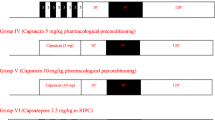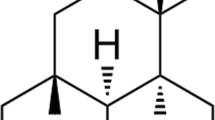Abstract
Skeletal muscle ischaemia–reperfusion-induced acute remote injury is mediated by activated neutrophils and formation of free radicals. Several investigators have demonstrated that the opioid pathway is involved in tissue preservation during hypoxia or ischaemia. Tramadol hydrochloride is an effective analgesic used for severe acute and chronic pain conditions. The present study was designed to investigate the potential protective effects of tramadol hydrochloride on cerebral oxidative stress and damage as well as lipid peroxidation, brain oedema and histological changes induced by hind limb ischaemia and reperfusion injury in rats. Thirty-six male Wistar rats were randomly allocated into two experimental groups: ischaemia–reperfusion (group I) and ischaemia–reperfusion + tramadol hydrochloride (group II). Hind limb ischaemia was induced by clamping the femoral artery. After 2-h ischaemia, the clamp from the femoral vessels was removed and the animal underwent 24-h reperfusion. Tramadol hydrochloride was given intravenously at a dose of 20 mg/kg, immediately before reperfusion. After reperfusion, animals were euthanized and the cerebral structure, lipid peroxidation and brain oedema in the cerebral tissue were assessed. Histopathological assessment of cerebral injury was split into four grades. The extent of lipid peroxidation was measured by estimating the amount of malondialdehyde. Brain oedema was calculated as the percentage water content of the brain. Brain oxidative stress and damage were significantly attenuated by treatment with tramadol hydrochloride. Compared with the ischaemia–reperfusion group, histological changes in brain tissues (p < 0.006), lipid peroxidation (p < 0.004) and brain oedema (P < 0.002) were significantly decreased in the ischaemia reperfusion plus tramadol hydrochloride group. These findings suggest that tramadol hydrochloride is neuroprotective and alleviates cerebral injuries induced by hind limb ischaemia–reperfusion in rats.




Similar content being viewed by others
References
Abbott NJ, Patabendige AA, Dolman DE, Yusof SR, Begley DJ (2010) Structure and function of the blood–brain barrier. Neuro biol Dis 37:13–25
Akhtar M, Pillai KK, Vohora D (2008) Effect of thioperamide on oxidative stress markers in middle cerebral artery occlusion model of focal cerebral ischemia in rats. Human Expt Toxicol 27:761–767
Aruoma OI, Halliwell B, Hoey BM (1989) The antioxidant action of N-acetylcysteine: its reaction with hydrogen peroxide, hydroxyl radical, superoxide, and hypochlorous acid. Free Radic Biol Med 6:593–597
Asano T, Shigeno T, Joshita H (1987) A novel concept on the pathogenic mechanism underlying ischemic brain edema: relevance of free radicals and eicosanoids. Acta Neuro chir 41(suppl)):85–94
Ashrafzadeh Takhtfooladi M, Jahanshahi A, Jahanshahi GH, Sotoudeh A, Ashrafzadeh Takhtfooladi H, Khansari M (2012) Protective effect of N-acetylcysteine on kidney as a remote organ after skeletal muscle ischemia-reperfusion. Acta Cirúrgica Brasileira 27(9):611–615
Beyersdorf F, Unger A, Wildhirt A (1991) Studies of reperfusion injury in skeletal muscle: preserved cellular viability after extended periods of warm ischemia. J Cardio vasc Surg 32:664–676
Bilir A, Erkasap N, Koken T (2007) Effects of tramadol on myocardial ischemia-reperfusion injury. Scand Cardiovasc J 41:242–247
Blaisdell FW (2002) The pathophysiology of skeletal muscle ischemia and the reperfusion syndrome: a review. Cardio vasc Surg 10:620–630
Brown GC (2010) Nitric oxide and neuronal death. Nitric Oxide 23:153–165
Chacon MR, Jensen MB, Sattin JA, Zivin JA (2008) Neuroprotection in cerebral ischemia:emphasis on the saint trial. Curr Cardiol Rep 10:37–42
Chen CA, Wang TY, Varadharaj S, Reyes LA, Hemann C, Talukder MA, Chen YR, Druhan LJ, Zweier JL (2010) S-glutathionylation uncouples eNOS and regulates its cellular and vascular function. Nature 468:1115–1118
Cimarosti H, Lindberg C, Bomholt SF, Rønn LC, Henley JM (2008) Increased protein sumoylation following focal cerebral ischemia. Neuropharmacology 54:280–289
Dirnagl U, Iadecola C, Moskowitz MA (1999) Pathobiology of ischemic stroke: an integrated view. Trends Neurosci 22:391–397
Driessen B, Reimann W, Giertz H (1993) Effects of the central analgesic tramadol on the uptake and release of noradrenaline and dopamine in vitro. Br J Pharmacol 108:806–811
Galley HF, Howdle PD, Walker BE (1997) The effect of intravenous antioxidants in patients with septic shock. Free Radic Biol Med 23:768–774
Gilgun-Sherki Y, Rosenbaum Z, Melamed E, Offen D (2002) Antioxidant therapy in acute central nervous system injury: current state. Pharmacol Rev 54:271–284
Green AR (2008) Pharmacological approaches to acute ischaemic stroke: reperfusion certainly, neuroprotection possibly. Br J Pharmacol 153(Suppl 1):S325–338
Hashiguchi A, Yano S, Morioka M, Hamada J, Ushio Y, Takeuchi Y, Fukunaga K (2004) Up-regulation of endothelial nitric oxide synthase via phosphatidylinositol 3-kinase pathway contributes to ischemic tolerance in the CA1 subfield of gerbil hippocampus. J Cereb Blood Flow Metab 24:271–279
Iglesias M, Segura MF, Comella JX, Olmos G (2003) Mu-opioid receptor activation prevents apoptosis following serum withdrawal in differentiated SH-SY5Y cells and cortical neurons via phosphatidylinositol 3-kinase. Neuropharmacology 44:482–492
Janardhan V, Qureshi AI (2004) Mechanisms of ischemic brain injury. Current Cardiology Reports 6:117–123
Kereans S, Moneley D, Murrary P (2001) Oral vitamin C attenuates acute ischaemia-reperfusion injury in skeletal muscle. J Bone Joint Surg Br 83(8):1202–1206
Klatzo I (1967) Neuropathological aspect of brain edema. JNeuropatholExpNeurol 26:1–14
Kogure K, Busto R, Scheinberg P (1981) The role of hydrostatic pressure in ischemic brain edema. Ann Neurol 9:273–282
Kondo T, Reaume AG, Huang TT, Murakami K, Carlson E, Chen S, Scott RW, Epstein CJ, Chan PH (1997) Edema formation exacerbates neurological and histological outcomes after focal cerebral ischemia in CuZn superoxide dismutase gene knockout mutant mice. Acta Neurochir, Suppl 70:62–64
Lenzsér G, Kis B, Bari F, Busija DW (2005) Diazoxide preconditioning attenuates global cerebral ischemia-induced blood–brain barrier permeability. Brain Res 1051:72–80
Li C, Jackson RM (2002) Reactive species mechanisms of cellular hypoxia reoxygenation injury. American Journal of Physiology-Cell Physiology 282:C227–C241
Liu K, Li Q, Zhang L, Zheng X (2009) The dynamic detection of NO during stroke and reperfusion in vivo. Brain Inj 23:450–458
Liu X, Chen H, Zhan B, Xing B, Zhou J, Zhu H, Chen Z (2007) Attenuation of reperfusion injury by renal ischemic postconditioning: the role of NO. Biochem Biophys Res Commun 359:628–634
Liu Z, Liu Q, Cai C, Xu CH (2011) Calcitonin gene-related peptide prevents blood–brain barrier injury and brain edema induced by focal cerebral ischemia reperfusion. Regul Pept 171:19–25
Li-Ze X, Jing Y, Qiang W, Zhi-hong LU (2007) Involvement of κ and μ-opioid receptors in the delayed cerebral ischemic tolerance induced by repeated electroacupuncture preconditioning in rats. Chin Med J 120:394–399
Manocha A, Sharma KK, Mediratta PK (2005) On the mechanism of anticonvulsant effect of tramadol in mice. Pharmacol Bio chem Behav 82:74–81
Nagakannan P, Shivasharan B, Thippeswamy B, Veerapur V (2012) Effect of tramadol on behavioral alterations and lipid peroxidation after transient forebrain ischemia in rats. J Toxicology Mechanisms and Methods 22(9):674–678
Olanow CW (1993) A radical hypothesis for neurodegeneration. Trends Neurosci 16:439–444
Ozbal S, Erbil G, Kocdor H, Tugyan K, Pekcetin C, Ozogul C (2008) The effects of selenium against cerebral ischemia-reperfusion injury in rats. Neurosci Lett 438:265–269
Peng B, Guo Q, He Z (2012) Remote ischemic postconditioning protects the brain from global cerebral ischemia/reperfusion injury by up-regulating endothelial nitric oxide synthase through the PI3K/Akt pathway. Brain Research 445:92–102
Raffa RB, Friderichs E, Reimann W, Shank RP, Codd EE, Vaught JL (1992) Opioid and nonopioid components independently contribute to the mechanism of action of tramadol, an ‘atypical’ opioid analgesic. J Pharmacol Exp Ther 260:275–285
Rastaldo R, Pagliaro P, Cappello S, Penna C, Mancardi D, Westerhof N, Losano G (2007) Nitric oxide and cardiac function. Life Sci 81:779–793
Sagach F, Scrosati M, Fieldingc J (2002) The water-soluble vitamin E analogue Trolox protects against ischaemia/reperfusion damage in vitro and ex vivo. A comparison with vitamin E. Pharmacol Res 45(6):435–439
Schillier HJ, Reilly PM, Bulkley GB (1993) Antioxidant therapy. Crit Care Med 21:92–102
Shimamura N, Matchett G, Solaroglu I, Tsubokawa T, Ohkuma H, Zhang J (2006) Inhibition of integrin alpha v beta3 reduces blood–brain barrier breakdown in focal ischemia in rats. J Neurosci Res 84:1837–1847
Xi-Qiao Z, Xiao NZ, Hui K, Xiu LS (2008) Neuroprotective effects of berberine on stroke models in vitro and in vivo. Neurosci Lett 447:31–36
Yabe Y, Kobayashi N, Nishihashi T (2001) Prevention of neutrophil-mediated hepatic ischemia/reperfusion injury by superoxide dismutase and catalase derivatives. JPET 298(3):894–899
Yousuf S, Atif F, Ahmad M, Hoda N, Ishrat T, Khan B, Islam F (2009) Resveratrol exerts its neuroprotective effect by modulating mitochondrial dysfunctions and associated cell death during cerebral ischemia. Brain Research 1250:242–253
Zhang J, Yan G, Liao J (2011) Leptin attenuates cerebral ischemia/reperfusion injury partially by CGRP expression. Eur J Pharmacol 671:61–69
Zhang Z, Chen T, Kirsch JR, Toung TJK, Traystman RJ, Koehler RC, Hurn PD, Bhardwaj A (2003) Kappa-opioid receptor selectivity for ischemic neuroprotection with BRL 52537 in rats. Anesth Analg 97:1776–1783
Zhao HG, Sun XC, Xian XH, Li WB, Zhang M, Li QJ (2007) The role of nitric oxide in the neuroprotection of limb ischemic preconditioning in rats. Neurochem Res 32:1919–1926
Zhao HX, Wang XL, Wang YH, Wu Y, Li XY, LV XP, Zhao ZQ, Zhao RR, Liu HR (2010) Attenuation of myocardial injury by postconditioning: role of hypoxia inducible factor-1alpha. Basic Res Cardiol 105:109–118
Author information
Authors and Affiliations
Corresponding author
Rights and permissions
About this article
Cite this article
Takhtfooladi, M.A., Jahanshahi, A., Sotoudeh, A. et al. Neuroprotective effects of tramadol on cerebral injuries caused by hind limb ischaemia/reperfusion in rats. Comp Clin Pathol 23, 1141–1146 (2014). https://doi.org/10.1007/s00580-013-1753-1
Received:
Accepted:
Published:
Issue Date:
DOI: https://doi.org/10.1007/s00580-013-1753-1




